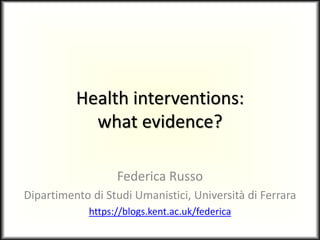
Health interventions evidence guide
- 1. Health interventions: what evidence? Federica Russo Dipartimento di Studi Umanistici, Università di Ferrara https://blogs.kent.ac.uk/federica
- 2. Overview Individual health interventions (evidence-based medicine) Evidential pluralism Evidential pluralism and evaluation of interventions Integration of evidence Guidelines for using evidence of mechanisms
- 4. Evidence based medicine is the conscientious, explicit, and judicious use of current best evidence in making decisions about the care of individual patients. (Sackett et al., 1996)
- 6. Evidence hierarchies Developed by e.g.: NICE, Oxford Centre for Evidence-based medicine, … A common claim: RCTs are better than observational studies, which are better than any other type of evidence and better than mechanistic reasoning
- 7. RCTs / statistics Arguments developed so far concentrate on the top of the hierarchy. We concentrate on the bottom part. Mechanisms
- 9. The thesis To establish a causal claim, one normally needs to establish two things: that a cause makes a difference to the effect, and that there is a mechanism from cause to effect Russo and Williamson Interpreting causality in the health sciences, ISPS 2007 Generic vs. single-case causality. The case of autopsy. EJPS 2011 Epistemic causality and evidence-based medicine. HPLS 2011 EnviroGenomarkers. The interplay between difference-making and mechanisms. MedSt 2012
- 10. Disambiguation Mechanistic evidence vs evidence of mechanisms Difference-making evidence vs evidence of difference-making Evidence vs evidence-gathering methods Illari, P. Disambiguating the Russo-Williamson Thesis, ISPS 2011
- 11. What mechanism? What mechanism ought to support a causal claim? Fully-known? Confirmed? Plausible? Gillies D. The Russo-Williamson thesis and the question of whether smoking causes heart disease, in Causality in the Sciences. 2011
- 12. A thesis about the epistemology of causality How to establish causal claims Methodological implications What evidence-gathering methods to use to establish causal claims
- 13. EVIDENTIAL PLURALISM AND EVALUATION OF INTERVENTIONS
- 14. The analogy of reinforced concrete Evidence: integration, not substitution Integration helps to tackle more problems Difference making and mechanisms help each other with their respective weaknesses Difference making helps with masking Mechanisms helps with confounding The more integrated, the merrier
- 15. Mechanisms help Study design External validity Individual diagnosis and treatment / health interventions
- 16. How to evaluate evidence of mechanisms?
- 17. Categories of evidence of mechanism C E C E 1. That there is a specific linking mechanism 2. That there is some kind of linking mechanism or other 3. That there is no linking mechanism C E
- 18. What evidence of mechanism is 1. Evidence of the existence and nature of the entities and activities of a linking mechanism, and their organization. – In vitro evidence – Animal experiments – Analogous / similar mechanisms – Autopsy – Simulation – Even RCTs… 2. Evidence that suggests that a linking mechanism does not or could not exist. – Well established knowledge • Energy constraints on biochemical mechanisms • Comparative studies C E C E C E
- 19. Quality of evidence of mechanism Desiderata for quality assessment: We do not want to provide a rigid hierarchy or a ticklist, but something more fluid. We want to move away from the idea that there is some baseline method which everything can be judged in relation to (as RCTs currently function). We want to provide an assessment of mechanisms ultimately to be integrated with an assessment of the complementary evidence of difference-making.
- 20. Quality of evidence of mechanism Pluses Each independent method for detection of entity/interaction Each independent research group confirming the result More entities in the mechanism found More links in the mechanism established Analogous mechanisms known Robust, reproducible in different conditions Minuses Single method used for detection of entity/interaction Single research group confirming the result Fewer entities in the mechanism found Fewer links in the mechanism established No analogous mechanisms known Fragile, not reproducible in slightly varying conditions
- 21. Integration in practice Observational studies in principle can be upgraded to the level of an RCT. But in practice they are not. Our model allows the integration of observational with good mechanistic evidence.
- 22. Assess evidence of difference- making Assess evidence of mechanism Assess the integration of your total evidence
- 23. TO SUM UP AND CONCLUDE
- 24. Evidential pluralism What it is A thesis about what evidence is needed for causal assessment A thesis about evaluating evidence But it is not a rigid tick-list The same item of evidence can be evidence of both difference making and of mechanisms What it isn’t ‘Normally’ does not imply no exceptions Evidence of mechanism does not imply we know the mechanism in full detail Mechanisms do not replace RCTs Mechanisms are not infallible Mechanisms are not ‘stories’. We talk about evidence.
- 25. The more integrated, the merrier Evidence of difference-making and of mechanisms Individual diagnosis / treatment Public health interventions Regain generality of causal reasoning Seek ‘help’ from different available sources of evidence No gold standards, but best integrated practices
Hinweis der Redaktion
- Giovanni Leonardi studies of toxic chemicals in drinking water. Jan Vandenbroucke assessment of the discovery that smoking causes lung cancer.
